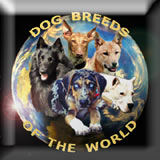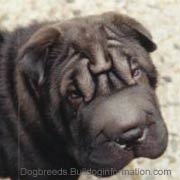Shar Pei
(Appearance, Different Types,
Five Point Red, Wrinkles, Eyes, Ears)
.
.
.
.
Shar-Pei
(Complete Pet Owner's Manual) (Paperback)
by Tanya Ditto
More information
Chinese Shar-Pei:
A Comprehensive Guide to Owning and Caring for Your Dog (Kennel Club Dog Breed Series)
(Hardcover)
by Juliette Cunliffe
More information

The Five Points are defined as the nose, tongue, anus, paws and area surrounding the eyes in a cream-colored dog. If these five points are red we speak of a Five Point Red Shar-Pei. Even though the blue tongue is considered typical of the breed and a pink-red tongue is considered a fault, a Five Point Red Shar-Pei (thus with pink-red tongue) is considered superior. The reason is that the Five Point Red seem to be more ancient in the breed than the blue tongue. If the dog itself is red that counts as the fifth point instead of the eyes.
A Five Point Red Shar Pei is believed to bring good fortune to a house. For the Chinese people red is an auspicious color representing growth, prosperity, and grand ideal. It is therefore the most welcomed color of the Chinese people. In a traditional Chinese marriage, red is the main theme color for decoration.
One of the distinctive features of this breed are the loose skin and the wrinkles over head and body. The loose coat is a reminiscence of the Shar Pei's fighting dog's ancestry: it allowed the dog to turn over with ease and escape the grip of its opponent.
The wrinkles on the forehead are called the "guarding lines", and the tighter it is, the more the dog was considered a good guard dog. The guarding line in the middle of the head going inward is called the rat line, and indicates if the dog is a good ratter. The guarding lines on the dog's forehead are said to represent the Chinese classical symbol for longevity.
Large felines have the same type of wrinkles on the the forehead that confer them the status of king, another reading of the Chinese character. The mastiff breeds also possess such wrinkles. The wrinkles are therefore also known as "Wong's features" or sovereign's look.
The wrinkles should be defined enough to render the character of sovereignty, but without being too exaggerated. The wrinkles on the head should not obstruct the eyes. Excessive wrinkles are considered a genetic fault.
Two major changes in the gene pool occured when new blood was introduced into the Shar Pei's gene pool in the 1960's and 1990's. This resulted in the development of different Shar Pei types, with:
- two types of mouths (Bone Mouth and Meat Mouth),
- the Bone mouth itself can be divided into two types of muzzles (Roof tile muzzle and toad muzzle)
- two types of coats (horse coat and brush coat)
- three types of tails: a sicle tail (small or large curve), spear tail (straight like a spear pointing up into the sky) or coin tail (single or double curl, like the Pug dog).
Spear Carrying Tail
Dam Cheung Mei
Photos courtesy of the Shar Pei Club of Hong Kong
Breeders keeping close to the original Chinese Shar pei describe their dogs as bone mouth, horse coat, calabash head (Wu Lo Tau) and coin tail. These Shar peis have kept close to the Dali traditional gene pool.
A Bone, Gwat zhui (also called traditional or working type) mouth is basically a muzzle with no padding or bulge on top of the muzzle, but only bone, hence the name. Actually, the bulge on top of the muzzle is a feature typically seen in the various recent breed standards, but it is not a traditional Shar-Pei feature. Because of its bony look the bone mouth muzzle may look less blunt than a Meat mouth.
The Meat mouth, Yok zhui (also known as 'Modern', American or non-sporting type) has more 'meat' on their muzzle.
The traditional Bone mouth can be further subdivided into "roof tile mouth" and "toad mouth". If the muzzle looks like a roundish roof tile when viewed from the top, it is called a "roof tile mouth". The "Pit Bull" type muzzle known as "toad mouth", has wide jaws in the shape of a toad's mouth. The the toad mouth muzzle is shorter than that of a roof tile mouth. A tweener or Gwat yok zhui (in Cantonese) is the term used to designate a muzzle halfway between these two types, but this type is not encouraged by most Shar pei fanciers. Both these muzzle types are considered traditional by the original Shar Pei fanciers.
These changes in the Shar Pei's muzzle are the result of two subsequent changes in the dog's gene pool. A first change in the Shar Pei's morphology occured in the 1960's and 1970's when breeders infused Pit Bull and Boxer blood into the Shar Pei's gene pool, which gave the Pit Bull or toad mouth muzzle. A more marked distinction occured in the 1990's with the emergence of the Meat mouth. One option could be to split the breed into two types, as has been done for the Akita.
Shar Pei ears
The Shar pei's ears should be small and set parallel above the eyes on top of the skull . They should be proportionally small to the skull, but not overly small.
The ears of the traditional Sharpei come in a variety of forms, each with their own name: Hinhok yi (clam shell ears) and Wan yi (mushroom ears). The first type resemble a clam shell, the second black Chinese mushrooms.






